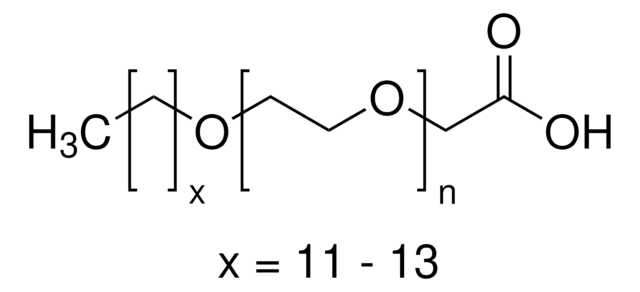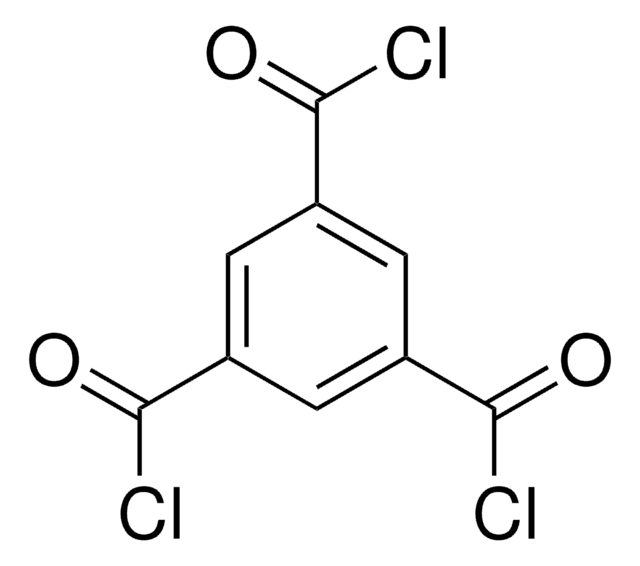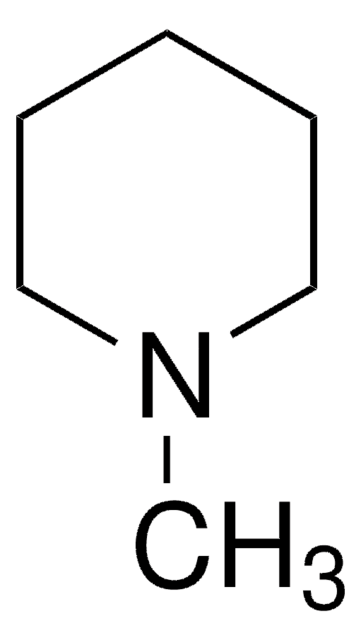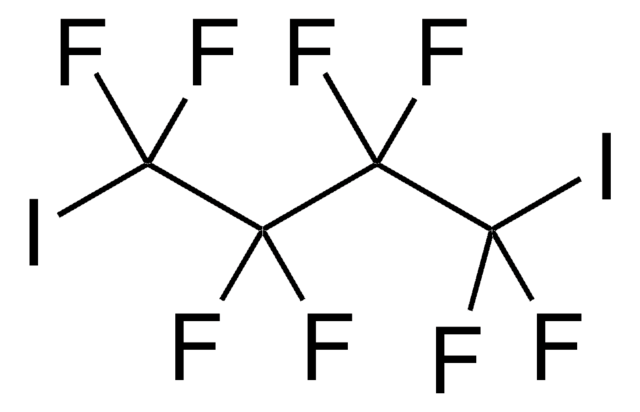Wszystkie zdjęcia(1)
Key Documents
473197
Poly(ethylene glycol) 4-nonylphenyl 3-sulfopropyl ether potassium salt
Synonim(y):
Polyethylene glycol
Zaloguj sięWyświetlanie cen organizacyjnych i kontraktowych
About This Item
Polecane produkty
Postać
viscous liquid
współczynnik refrakcji
n20/D 1.473
tw
81 °C (lit.)
gęstość
1 g/mL at 25 °C (lit.)
Szukasz podobnych produktów? Odwiedź Przewodnik dotyczący porównywania produktów
Powiązane kategorie
Opis ogólny
Poly(ethylene glycol) 4-nonylphenyl 3-sulfopropyl ether potassium salt is an anionic PEG derivative that can be used as a soft polyoxyethylene sulfonate anion.
Zastosowanie
Poly(ethylene glycol) 4-nonylphenyl 3-sulfopropyl ether potassium salt can be used as an anionic surfactant in the fabrication of hierarchical β-Ni(OH)2 microspheres and nickel oxide hollow spheres for supercapacitor applications.
Poly(ethylene glycol) 4-nonylphenyl 3-sulfopropyl ether potassium salt was also demonstrated to be effective for protecting thermostable DNA polymerase during amplification reactions conducted at a temperature ranging from about 40° C to greater than 100° C.
DNA polymerases, such as Taq, do become inactive over time at the high temperatures utilized in thermal cycling reactions such as polymerase chain reaction (PCR). It has been discovered that thermostable DNA polymerases could be protected from such heat inactivation by contacting the polymerase with poly(ethylene glycol) 4-nonylphenyl 3-sulfopropyl ether potassium salt during a thermal cycling process, and improve the specificity of amplification.
Poly(ethylene glycol) 4-nonylphenyl 3-sulfopropyl ether potassium salt was also demonstrated to be effective for protecting thermostable DNA polymerase during amplification reactions conducted at a temperature ranging from about 40° C to greater than 100° C.
DNA polymerases, such as Taq, do become inactive over time at the high temperatures utilized in thermal cycling reactions such as polymerase chain reaction (PCR). It has been discovered that thermostable DNA polymerases could be protected from such heat inactivation by contacting the polymerase with poly(ethylene glycol) 4-nonylphenyl 3-sulfopropyl ether potassium salt during a thermal cycling process, and improve the specificity of amplification.
Postać fizyczna
~20 EO/mole
Informacje prawne
The composition of this product in combination with thermostable DNA polymerase (including, but not limited to, Taq polymerase) is covered by US Patent No. 7,972,828 and related foreign equivalents. In addition, use of this product may be covered by US Patent No. 8,404,464 and related foreign equivalents.
This page may contain text that has been machine translated.
Kod klasy składowania
10 - Combustible liquids
Klasa zagrożenia wodnego (WGK)
WGK 3
Temperatura zapłonu (°F)
No data available
Temperatura zapłonu (°C)
No data available
Środki ochrony indywidualnej
Eyeshields, Gloves
Wybierz jedną z najnowszych wersji:
Masz już ten produkt?
Dokumenty związane z niedawno zakupionymi produktami zostały zamieszczone w Bibliotece dokumentów.
Fabrication of novel hierarchical beta-Ni (OH) 2 and NiO microspheres via an easy hydrothermal process
Kuang D, et al.
The Journal of Physical Chemistry C, 113(14), 5508-5513 (2009)
Reactive CeO2 nanofluids for UV protective films
Maniglia R, et al.
Journal of Colloid and Interface Science, 506(4), 346-354 (2017)
Solvent-free protein liquids and liquid crystals.
Adam W Perriman et al.
Angewandte Chemie (International ed. in English), 48(34), 6242-6246 (2009-07-16)
Rational synthesis of hierarchically porous NiO hollow spheres and their supercapacitor application
Yan X, et al.
Materials Letters, 95(14), 1-4 (2013)
Functionalized ZnO nanoparticles with liquidlike behavior and their photoluminescence properties
Bourlinos AB, et al.
Small, 2(4), 513-516 (2006)
Nasz zespół naukowców ma doświadczenie we wszystkich obszarach badań, w tym w naukach przyrodniczych, materiałoznawstwie, syntezie chemicznej, chromatografii, analityce i wielu innych dziedzinach.
Skontaktuj się z zespołem ds. pomocy technicznej![(1S,4S)-(−)-2-Boc-2,5-diazabicyclo[2.2.1]heptane 95%](/deepweb/assets/sigmaaldrich/product/structures/401/063/1eb3be94-6385-4815-8b42-ff76c097cc27/640/1eb3be94-6385-4815-8b42-ff76c097cc27.png)








